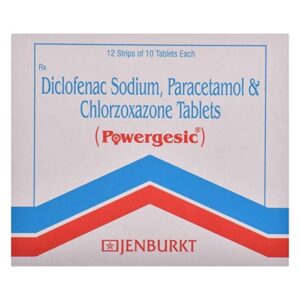DICLOFENAC + PARACETAMOL + CHLORZOXAZONE
Diclofenac: Diclofenac is a nonsteroidal anti-inflammatory drug (NSAID) commonly used to relieve pain, reduce inflammation, and alleviate fever. It is available in various forms such as tablets, capsules, gels, patches, and injections.
The drug works by inhibiting the production of certain chemicals in the body known as prostaglandins. Prostaglandins play a role in inflammation, pain, and fever. By reducing the production of these chemicals, diclofenac helps to reduce pain and inflammation.
Diclofenac can be used to treat a variety of conditions including arthritis, menstrual cramps, migraines, dental pain, sports injuries, and post-surgical pain. It can also be prescribed for long-term conditions like rheumatoid arthritis and osteoarthritis.
The exact dose of diclofenac can vary depending on the specific formulation and the condition being treated. The recommended dose for oral tablets generally ranges from 25 to 50 mg taken two to three times a day. For topical gels or patches, a thin layer is applied to the affected area up to four times a day. Injections are typically administered by a healthcare professional.
As with any medication, diclofenac can cause side effects. Common side effects include stomach upset, heartburn, nausea, diarrhea, dizziness, and headache. In some cases, diclofenac can lead to more serious side effects such as stomach ulcers, bleeding, liver or kidney problems, and allergic reactions. It is important to follow the prescribed dose and seek medical attention if any severe side effects occur.
Diclofenac may interact with certain other medications, including blood thinners, diuretics, and certain antidepressants. It is important to inform your healthcare provider about all the medications you are currently taking to avoid potential drug interactions or complications.
Overall, diclofenac is an effective medication for relieving pain and reducing inflammation, but it should be used with caution and under medical supervision to minimize the risk of side effects.
Paracetamol: Paracetamol, also known as acetaminophen, is a widely used medication for pain relief and fever reduction. It belongs to the class of analgesic and antipyretic drugs. Paracetamol is available over-the-counter and in prescription-strength formulations.
The primary use of paracetamol is to alleviate mild to moderate pain, such as headache, toothache, muscle aches, and back pain. It is also effective in reducing fever associated with common colds and flu, as well as post-vaccination fever. Paracetamol is commonly used in the treatment of conditions such as arthritis and menstrual pain.
The exact mechanism of action of paracetamol is not fully understood. It is thought to work by inhibiting the production of prostaglandins in the brain, which are responsible for transmitting pain and fever signals. Paracetamol is also believed to act on the hypothalamic heat-regulating center to reduce fever.
The dose of paracetamol varies depending on the age and weight of the individual. For adults and children aged 12 and above, the usual dose is 500-1000 mg every 4-6 hours, up to a maximum of 4000 mg in 24 hours. It is essential to follow the recommended dose and not exceed the maximum daily limit, as higher doses can lead to liver damage.
While paracetamol is generally considered safe when used as directed, it may cause side effects in some individuals. Common side effects include nausea, vomiting, stomach pain or upset, and rash. Serious allergic reactions to paracetamol are rare but possible. In rare cases, paracetamol may cause liver damage, especially when taken in high doses or with alcohol.
It is important to note that paracetamol can interact with certain medications, such as blood thinners and certain antibiotics. Patients should consult their healthcare provider or pharmacist before taking paracetamol if they have any underlying medical conditions or are taking other medications.
Overall, paracetamol is a widely used and effective medication for pain relief and fever reduction when used appropriately. However, it is crucial to use it according to the recommended dose and seek medical advice if any side effects or concerns arise.
Chlorzoxazone: Chlorzoxazone is a muscle relaxant drug that is primarily prescribed for the relief of discomfort caused by muscle spasms or musculoskeletal conditions such as strains, sprains, and injuries. It is usually used in combination with rest, physical therapy, and other treatments to provide relief from muscle pain and stiffness.
The exact mechanism of action of chlorzoxazone is not fully understood. It is believed to work by acting on the central nervous system to inhibit certain reflexes and decrease muscle spasms. It is thought to have a direct effect on the skeletal muscle, rather than acting directly on the motor neurons in the spinal cord.
Chlorzoxazone is available in tablet form and is typically taken orally. The usual recommended adult dose is 500 mg to 750 mg three to four times a day. However, the specific dosage can vary depending on the individual’s condition and the healthcare provider’s instructions. It is important to follow the prescribed dosage and schedule.
As with any medication, there can be side effects associated with chlorzoxazone. Common side effects include drowsiness, dizziness, lightheadedness, headache, upset stomach, and nausea. Some individuals may also experience allergic reactions, which may manifest as rash, itching, swelling, or difficulty breathing. If any of these more severe side effects occur, it is important to seek medical attention immediately.
It is worth noting that chlorzoxazone may cause drowsiness or dizziness, so individuals taking this medication should use caution while driving or operating heavy machinery. Additionally, it is important to avoid alcohol consumption while taking chlorzoxazone as it may increase the sedative effects of the drug.
As with any medication, it is important to discuss the potential benefits and risks with a healthcare provider before starting chlorzoxazone. They can provide personalized advice based on individual health conditions and help monitor for any potential side effects or interactions with other medications.

